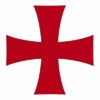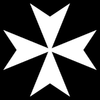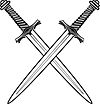- Knights Templar (Freemasonry)
-
 A cross and crown laid upon a cross pattée inscribed with "In Hoc Signo Vinces" resting upon downward pointing swords in saltire is often used to represent the Knights Templar.
A cross and crown laid upon a cross pattée inscribed with "In Hoc Signo Vinces" resting upon downward pointing swords in saltire is often used to represent the Knights Templar.
(The various symbols used allude to the orders of the body, though the cross and crown is often used alone as well.)This article is part of or related
to the Knights Templar seriesKnights Templar
- History of the Knights Templar
- Knights Templar legends
- Knights Templar Seal
- Grand Masters of the Knights Templar
- Knights Templar in England
- Knights Templar in Scotland
- List of Knights Templar
- List of places associated with the Knights Templar
Modern associations
- Knights Templar (Freemasonry)
- This page is about a Masonic organization. For the medieval Knights Templar, see Knights Templar. See also Knights Templar and popular culture.
The Knights Templar is an international philanthropic chivalric order affiliated with Freemasonry. Unlike the initial degrees conferred in a Masonic Lodge, which only require a belief in a Supreme Being regardless of religious affiliation, the Knights Templar is one of several additional Masonic Orders in which membership is open only to Freemasons who profess a belief in the Christian religion. The full title of this Order is The United Religious, Military and Masonic Orders of the Temple and of St John of Jerusalem, Palestine, Rhodes and Malta. The word "United" in this title indicates that more than one historical tradition and more than one actual Order are jointly controlled within this system. The individual Orders 'united' within this system are principally the Knights of the Temple (Knights Templar), the Knights of Malta, the Knights of St Paul, and only within the York Rite, the Knights of the Red Cross. The Order derives its name from the historical Knights Templar. One theory of the origins of Freemasonry claims direct descent from the historical Knights Templar through its final fourteenth-century members who took refuge in Scotland, or other countries where the Templar suppression was not enforced. Although the theory may not be dismissed, it is usually deprecated on grounds of lack of evidence by both masonic authorities[1] and historians.[2]
Contents
Administration
Knights Templar can exist either as part of the York Rite or as an independent organization. Though the York Rite and the independent versions share many similarities there are key differences which are described below.
Knights Templar as a part of the York Rite
Main article: York RiteA Knights Templar commandery is traditionally the final body that a member joins in the York Rite after the chapter of Royal Arch Masons and a council of Royal & Select Masters. Some jurisdictions, however, allow members to skip over membership in a council. A local Knights Templar commandery operates under a state-level Grand Commandery, however American commanderies also operate under The Grand Encampment of the United States. This is unique among American Masonic bodies, as most report to the state level alone.
While a chapter bestows the Royal Arch degrees, and a council bestows the Cryptic degrees, a Knights Templar commandery bestows three orders and one passing order onto its members. This is opposed to the standard degree system found elsewhere in Freemasonry, and they are the only ones not to deal with the Hiramic Legend.[3] The York Rite orders are:
- The Illustrious Order of the Red Cross
- The Passing Order of St. Paul, (or Mediterranean Pass)
- The Order of the Knights of Malta (or simply Order of Malta)
- The Order of the Temple
Knights Templar as an Independent Body
 The Cross pattée, symbol of the Order of the Temple in the independent body and Illustrious Order of the Red Cross.
The Cross pattée, symbol of the Order of the Temple in the independent body and Illustrious Order of the Red Cross.
Outside the York Rite, membership is by invitation only. Candidates are required to be Master Masons, and Royal Arch Masons, and to sign a declaration that they profess the Doctrine of the Holy and Undivided Trinity. In some Australian States, the requirement of being a Royal Arch Mason no longer applies.
Local bodies of Knights Templar are known as Preceptories; local bodies of Knights of St Paul are known as Chapters; local bodies of Knights of Malta are known as Priories; all operate under a Grand or Great Priory, often with an intermediate level of Provincial Priories. Although some jurisdictions maintain a separate Great Priory of the Temple and Great Priory of Malta (as, for example, in England), the Grand Master and other officers of both Great Priories hold simultaneous equal office in both bodies. Three degrees are administered in this system:
- The Degree of Knight Templar (Order of the Temple)
- The Degree of Knight of St. Paul (incorporating the Mediterranean Pass)
- The Degree of Knight of Malta (Order of Malta)
The Degrees or Orders
 The Cross and Crown, symbol of the Order of the Temple as found in the York Rite.
The Cross and Crown, symbol of the Order of the Temple as found in the York Rite.
The Degree of Knight of the Temple (Order of the Temple)
The original medieval Order of Knights Templar was established after the First Crusade, and existed from approximately 1118 to 1312. There is no known historical evidence to link the medieval Knights Templar and Masonic Templarism, nor do the Masonic Knights Templar organizations claim any such direct link to the original medieval Templar organization.[4] Though it has been said that its affiliation with Masonry is based on texts that indicate persecuted Templars found refuge within the safety of Freemasonry, the order itself states that "there is no proof of direct connection between the ancient order and the modern order known today as the Knights Templar."[5] The official motto of the Knights Templar is In Hoc Signo Vinces, the rendition in Latin of the Greek phrase "εν τούτῳ νίκα", en toutōi nika, meaning "in this [sign] you will conquer".
The Knight Templar degree is associated with elaborate regalia (costume) the precise detail of which varies between nations. The ritual draws upon the traditions of medieval Knights Templar, using them to impart moral instruction consistent with the biblical teachings of the Christian tradition.
The Degree of Knight of Malta (Order of Malta)
 The Maltese Cross, symbol of the Order of Malta.
The Maltese Cross, symbol of the Order of Malta.
This degree is universally associated with the Masonic Knights Templar. In the York Rite system it is conferred before the Templar Degree; in the 'stand-alone' tradition it is conferred subsequently to the Templar Degree. It is known by varying degrees of formality as the Order of Malta, or the Order of Knights of Malta, or the Ancient and Masonic Order of St John of Jerusalem, Palestine, Rhodes, and Malta. In practice this last and fullest version of the name tends to be reserved to letterheads, rituals, and formal documents.
The ceremony for conferring the degree (which is always worked in full) contains a mixture of masonic tradition, historical accounts of the Order of St John, moral teaching, and the communication of modes of recognition between members. A series of banners is employed in the ceremony, each representing one of the great battles of the historic medieval Order of St John, whose story is the basis of the moral teachings of the degree.
The Degree of Knight of St Paul (Order of St Paul)
 Two downward pointing swords in saltire, symbol of the Order of St Paul.
Two downward pointing swords in saltire, symbol of the Order of St Paul.
This degree is conferred as a prerequisite to becoming a Knight of Malta, in both the York Rite and independent 'stand-alone' versions of Knight Templar Freemasonry. The "Preliminary Declarations" of the Order of Malta ritual in England state of a candidate for the Order of Malta: "He must also have received the Degree of Knight of St Paul, including the Mediterranean Pass". The exact status of the 'Mediterranean Pass' has at times led to confusion as to whether this is the 'stub' of a separate degree. The English ritual book clarified this in its 1989 edition (and subsequent editions) by stating: "The Mediterranean Pass is one of the secrets of the Degree of Knight of St Paul".[6]
This degree is close to being a true 'side degree', in that a small group (usually three) of members of the degree take the candidate "to one side" (i.e. apart on his own) and simply communicate the secrets of the degree to him, without actually working the ceremonial ritual of the degree. The only respect in which the degree fails to meet the definition of a true 'side degree' is that a Chapter of the Order is formally opened and closed by the presiding officer, on either side of the secrets being communicated.
The Illustrious Order of the Red Cross (Order of the Red Cross)
Unique to the York Rite, the Illustrious Order of the Red Cross continues or reverts to the period of the Royal Arch Degree when the Israelites were returning from Babylon to Jerusalem to rebuild the Temple. Zerubbabel, their leader prevails upon King Darius to restore the Holy Vessels to the new Temple. They had been carried away by the Babylonian armies when the first Temple was destroyed. In presenting his plea before the King, the companion gives a powerful testimony to the almighty force of Truth.
The ritual places the candidate in the role of Zerubbabel and follows him through his journey to King Darius and his role in the Immemorial Discussion, as found in the apocryphal book, 1 Esdras. The purpose is to bridge the gap between Royal Arch Masonry, and the Chivalric Orders as well the Old Testament and the New Testament. The Illustrious Order of the Red Cross teaches the lessons of the triumph of truth.
It should not be confused with the Masonic Order known as the Red Cross of Constantine.
Templar traditions
Despite Freemasonry's general disclaimer that no one Masonic organization claims a direct heritage to the medieval Knights Templar, certain degrees and orders are obviously patterned after the medieval Order. These are best described as "commemorative orders" or degrees. Nevertheless, in spite of the fraternity's official disclaimers, some Masons, non-Masons and even anti-Masons insist that certain Masonic rites or degrees originally had direct Templar influence.
- American Masonic youth organizations such as the Order of DeMolay for young men are named after the last Grand Master Templar Jacques de Molay who was executed in the final suppression of the Templar order in the early 14th century.
- The Knight of Rose-Croix Degree in the "Ancient Accepted Scottish Rite", and honorary Orders like the Royal Order of Scotland are interpreted as evidence of a historical Templar-Masonic connection, though there is no factual basis for this belief.
- Rosslyn Chapel near Edinburgh has been suggested to be strong link between the Knights Templar and Freemasons due to reliefs combining Templar and Freemason symbolism. Rosslyn Chapel was indeed founded by William Sinclair, 1st Earl of Caithness.[7]
- Legends in certain degrees pertain to the involvement of Knights Under the command of Sir John De Bermingham, First and Last Earl of Louth aiding the excommunicated 14th Century Scottish King Robert the Bruce at the Battle of Bannockburn; however this is based on 18th century romance and is not supported by any evidence. This story is the basis for the degrees in the Royal Order of Scotland an invitational Masonic honorary organization.
- Templar connections have also been suggested through the Earls of Rosslyn (St. Clair, or Sinclair) a family with well documented connections with Scottish Freemasonry, one being a Grand Master of the Grand Lodge of Scotland.
- Many other old and new organizations are called "Knights Templar". However, organizations like the Order of the Solar Temple, Militi Templi Scotia,or the Sovereign Military Order of the Temple of Jerusalem are in no way related to Masonic Knights Templar, and share no relationship in either history, hierarchy, nor ritual.
See also
- Freemasonry
- List of Freemasons
- Masonic Lodge
- York Rite
- Scottish Rite
- Royal Order of Scotland
- National Treasure (film) (2004)
- Freemasonry in Malta
References
- The History Channel, Decoding the Past: The Templar Code, 2005, video documentary
- The History Channel, Mysteries of the Freemasons, 2006 video documentary
- Stephen Dafoe, The Compasses and the Cross, 2008. ISBN 0-85318-298-1
- Christopher L. Hodapp and Alice Von Kannon, The Templar Code For Dummies, 2007. ISBN 0-470-12765-1
- Sean Martin, The Knights Templar: History & Myths, 2005. ISBN 1-56025-645-1
- http://news.bbc.co.uk/2/hi/uk_news/magazine/7050713.stm
Notes
- ^ http://www.knightstemplar.org/faq1.html#origin [Knights Templar FAQ], accessed January 10, 2007.
- ^ "Freemasonry Today periodical (Issue January 2002)". Grand Lodge Publications Ltd. http://www.freemasonrytoday.com/19/p07.php. Retrieved 2011-05-28.
- ^ http://www.knightstemplar.org/faq1.html#member [Knights Templar FAQ - How to Become a Knight Templar]
- ^ Knights Templar FAQ/INFO Accessed 14 August 2007
- ^ http://www.knightstemplar.org/faq1.html#origin [Knights Templar FAQ - Origin]
- ^ Great Priory Ritual No 2, The Ancient & Masonic Order of St John of Jerusalem, Palestine, Rhodes, and Malta (published 1989, London), page 3.
- ^ National Geographic, The Secret Bible Part 1: The Knights Templar. Video Documentary
External links
Masonic Knights Templar organizations
- Grand Encampment of Knights Templar of the United States of America
- Sovereign Great Priory of the Knights Templar of Canada
- Knights Templar Eye Foundation
- Order of the Temple - Great Priory of Scotland
- The Web of Hiram Section on The Royal Exalted Religious and Military Order of Masonic Knights Templar of England and Wales at Bradford University
Masonic bodies associated with the York Rite Primary Bodies Honorary or Invitational Bodies Knights of the York Cross of Honour · Red Cross of Constantine · Allied Masonic Degrees · Royal Ark Mariners · Knight Masonry · York Rite Sovereign College · Holy Royal Arch Knight Templar Priests · Sovereign Order of Knights Preceptor · Grand College of Rites · Masonic Order of the Bath · Societas Rosicruciana in Civitatibus Foederatis · Reformed and Rectified Rite · Commemorative Order of St.Thomas of Acon · Royal Order of ScotlandCategories:- Masonic organizations
- Knights Templar
- History of the Knights Templar
Wikimedia Foundation. 2010.


